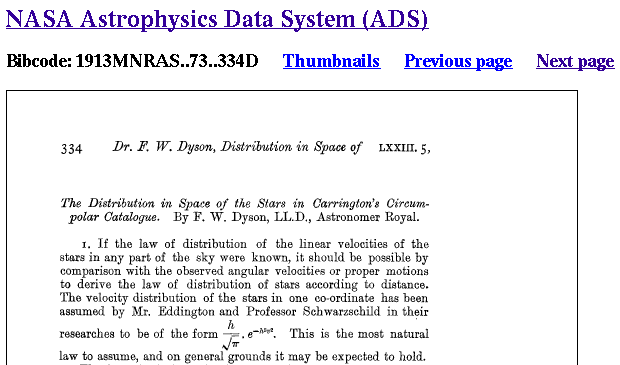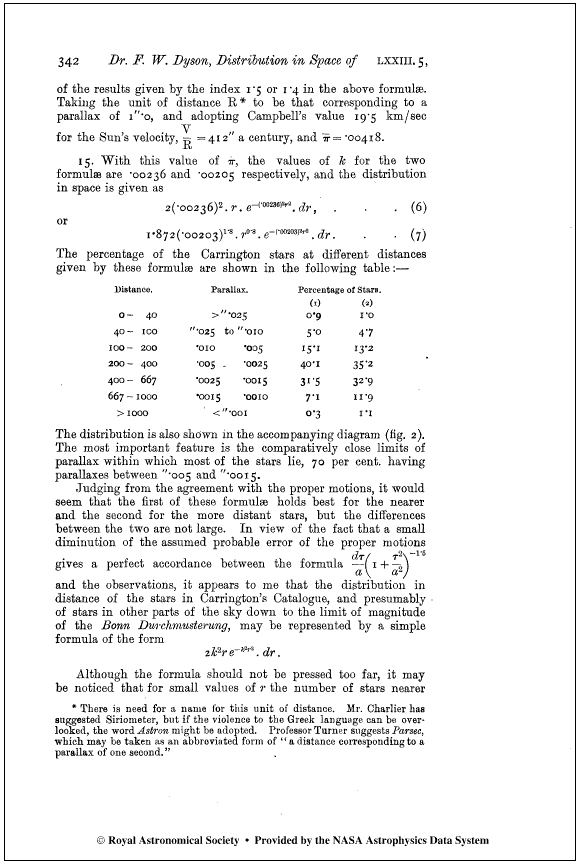
A discussion originally posted on sci.astro, Apr 2002
Poor Richard asked:
Does anyone here know the origin of this unit of measurement ? I know the definition of it, I am just curious who the first person to use it was ...
I answered:
Some information that might help:
- the first appearance of the word "parsec" in the title or abstract
of any paper in the ADS
http://adsabs.harvard.edu/abstract_service.html
occurs in 1922, in a work by Hertzsprung. The paper itself
isn't available via ADS, unfortunately
- a quick scan of papers in the 1870s and 1880s via ADS shows
that most astronomers contented themselves with quoting
parallaxes in arcseconds. A few used "light year" or
an equivalent phrase to express distance. I didn't
see "parsec" in the few papers I read.
- the book "Star Names: Their Lore and Meaning," by Richard Allen,
was published in 1899; at least, my copy is a facsimile
of an 1899 edition. Allen uses "light years" to express
the distance to Sirius and alpha Centauri, and the word
"parsec" doesn't appear in the index.
My guess is that the term was invented sometime after 1900. You might
look in books by Agnes Clerk or Simon Newcomb. The book "Parallax"
by Alan Hirshfield, published just last year, might be a good place
to look, too.
Later that day, I posted some additional information:
I did a little extra digging, and found this site describing
Herbert Hall Turner, who won the Bruce Medal in 1927:
http://www.phys-astro.sonoma.edu/BruceMedalists/Turner/index.html
The site says, "Turner is generally credited with coining the term parsec."
Searching ADS for papers by Turner, I see that he uses "light years"
to describe the distance to Nova Persei 1901, in a paper published
in Nov, 1918. He uses "parsecs" in a paper on stars in Monoceros,
published in Jan, 1921, but does not define it.
I leave further work to someone with a good library of old
astronomical journals. Sigh. Life was good when I was working
at Princeton -- the Dept. of Astrophysical Sciences had their own
library, with volumes of all the major journals going back to
volume 1, and nearly complete sets of even minor publications
like "The Observatory." Those were the good old days ... :-/
Martin Hardcastle found a good reference:
The OED says as its first quotation: 1913 F. W. DYSON in Monthly Notices R. Astron. Soc. LXXIII. 342 There is need for a name for this unit of distance... Professor Turner suggests Parsec, which may be taken as an abbreviated form of `a distance corresponding to a parallax of one second'.
I followed the reference using the ADS and posted a little more information:
Thanks, Martin! I have found the article itself via the ADS --
it appears in an article titled "Stars, Distribution and drift of,
The distribution in space of the stars in Carrington's
Circumpolar Catalogue". The attribution appears in a footnote
as Dyson discusses the distance to a star: the main text reads
... Taking the unit of distance R* to be that corresponding
to a parallax of 1.0 arcsec ...
and the footnote
* There is a need for a name for this unit of distance.
Mr. Charlier has suggested Siriometer, but if the violence
to the Greek language can be overlooked, the word ASTRON
might be adopted. Professor Turner suggests PARSEC,
which may be taken as an abbreviated form of "a distance
corresponding to a parallax of one second."
Can anyone trace the word further back than this?
You can see the full article at this link from the ADS . Below is the title page of the article:

and here, the page from the journal in which the word appears:
